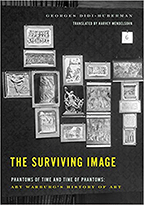 |
Georges Didi-Huberman. The Surviving Image: Phantoms of Time and Time of Phantoms: Aby Warburg’s History of Art. University Park: Penn State University Press, 2016.
Based on Aby Warburg’s Atlas Mnemosyne, this monumental, multilayered essay scrutinizes the substance and the process. Didi-Huberman relates theories of Renaissance art, deciphering the pathos of Mantegna and Botticelli’s nymphs with the movement of their draperies and the curl of their hair. These curls that can be compared to a serpent, an octopus, a fabric of knots or more broadly a rhizome, lead us to the mesmerizing apparatus Warburg conceived. From the artwork to its reproduction to its classification and eventually to its ruin and disappearance, The Surviving Image ends with the question of whether can we predict what, from the past, is destined to survive and haunt us in the future. The Surviving Image had a strong influence on my work as a scholar and even more as an artist, from the use of photography in the suspended ruins to the display of systems of inventories, typologies and archiving.
|